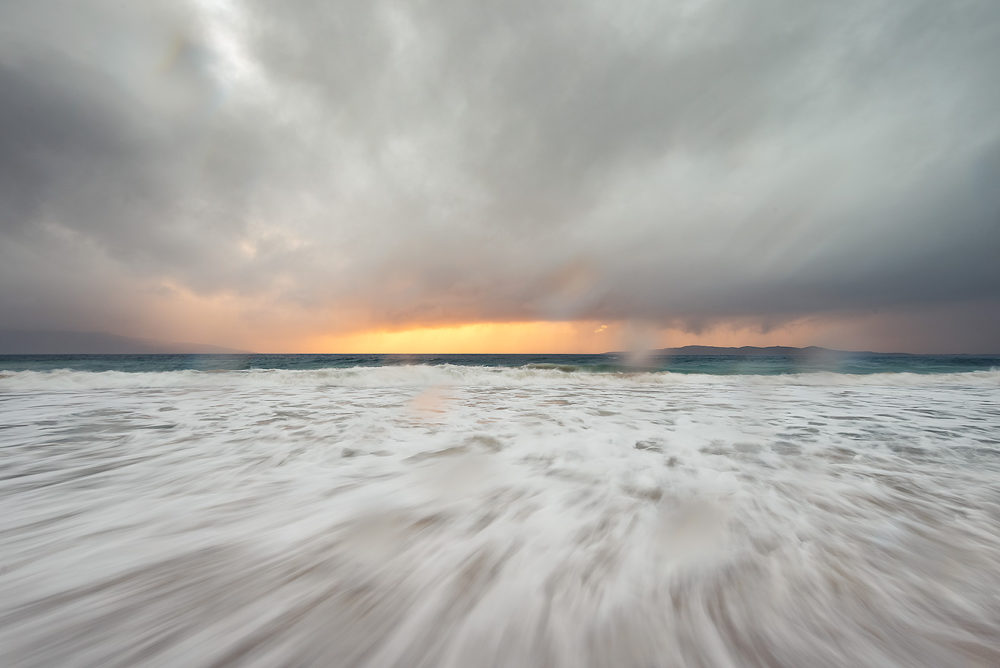Spirit of Place: The Essence of Landscape Photography
A couple of weeks ago, I was in the need of a truly wild experience. So, I headed to the Outer Hebrides of Scotland, to the wonderful Isle of Harris, in an endeavour to capture the authentic spirit of place. I packed my usual outdoor setup, but no matter the struggles I attempted to resolve, I got a lot of images with an unexpected yet charming flaw. It was extremely difficult to shoot during most evenings and mornings due to heavy rain and stormy weather. Moreover, the excitement of dynamic conditions makes you sometimes forget the basic rules. Lenses and filters don’t like the salty Atlantic Ocean either.
The common flaws here were in part technical aspects of photography that weren’t fulfilled to their finest. From being away from perfect sharpness to some composition rules that were on the need of being broken thanks to heavy winds blowing intensely around my camera and face.
Nevertheless, these images – even those with big water drops ruining the perfect nature of the shots – had a very pleasant thing for me. They even got a very fulfilling charm. They are meaningful to me not only because they capture the spirit of place, but also my place within that place. All the drama and soul are present in these shots. Therefore, these pictures that are far from being perfect are more natural to me than any other sharp shot that I could possibly took that day. They exhibit what I witnessed at that particular moment in time. They are my interpretation of the landscape, my manifestation of the subjective construction of reality.
So, I was wondering, what makes the “perfect” image?
The Good Old Ultraperfectionism
Landscape is perhaps the oldest genre in photography. After photographers detached themselves from the hazy and soft blurred nature of pictorialism, everything went extremely sharp. Since the appearance of the f/64 group – filled with great and talented photographers in love with straight realism – a lot of photography has been circling around perfectionism.
This isn’t a bad thing of course, don’t take me wrong. In the end, who doesn’t like to shoot with the sharpest combination of lens and camera available? But after this encounter with truly compelling images in the wild, I think it is necessary to pursue something else with more meaning than pure image sharpness, faultless composition and perfectly balanced exposures.
Chasing Bad Weather
Well, I must admit that I was an obsessed caretaker with cameras. So much that I wasn’t enjoying the act of picture taking to the fullest. When I finally got to the conclusion that a camera is just a tool and not a newborn, I started enjoying things into a whole new level. Go out and explore. A lot of new cameras are made to stand some really bad mistreatment. Invest in weather sealed gear, and you’ll forget about being so careful. You’ll start enjoying photography way better. This takes me to the next conclusion I made after this short trip to the Hebrides of Scotland.
Ironically, bad weather provides the most beautiful lighting conditions in the world and hence, fantastic opportunities for landscape photography due to the resulting dynamism in the natural elements. Try to pursue bad weather for dramatic skies and compelling images. There is nothing interesting in plain and dull skies. The trick to work with bad weather is to keep your gear decently protected from the weather (dust, salt, water etc.) and keeping everything still. A sturdy tripod is the best friend for any landscape photographer out there. Also, filters will make your photography life much more interesting.
But, there is another issue that will make things easier for you: planning things ahead and staying calm. By doing this, you’ll know exactly what you need to have in terms of lenses. After attaching one lens, you will not want to take it off when shooting within bad weather. Trust me, you just don’t want to do that. Moreover, filters often survive only one spray of salty water.
Meaning > Perfect Shots
Capturing things perfectly as a photographer is always a delight, and it feels like a true accomplishment. But after a while of capturing everything flawlessly and right on the spot, images start to feel dull. There is something else that needs to be added into the equation. That missing thing is meaning. And I’ve realisied that meaning beats out any means of perfection.
The ideal thing of course is to capture meaningful photos in the most sublime of ways. But you can’t have everything in life. Therefore, I rather capture the aesthetic, even when it is far away from being perfect than missing the moment thanks to a sheer pursuit of technical perfection.
A lot of these photographs depict some heavy odd spots due to drops bashing against my lens. The charm of this artifact is that they feel like they were shot under some really complex weather situations. And trust me, it was just like this. While reviewing these images I remembered this scene from the movie Children of Men shot by Emmanuel Lubezki. The drops of “blood” splashing in front of the lens gives a unique viewing experience. This is because it feels like one is inside the scene; everything feels chaotic, frantic and indeed real. Therefore, these drops do accentuate my interpretation of the landscape at that particular moment in time. They are part of my interpretation of the spirit of place that I have witnessed. And, believe me, they look great when actually printing the image.
Spirit of Place as Emphasis of Personal Vision
Photography is my latest passion. Honestly, it has been around longer than any other hobby I’ve embarked before. I’m not making a living thanks to photography, but I must admit that I’ve turned out to be pretty serious about it. When I started to read about photography, everything was about all the technical aspects from perfect exposures to millimetric compositions. That is important, but since I’m in love with photography, I want you to enjoy this discipline as much as I do. Hence, I’m encouraging everyone out there to sometimes forget about the technical stuff, and focus on enjoying life and nature to the fullest.
Learning the logics of exposure, the physics of lenses and cameras and even the various rules linked to composition could be achieved by anyone with enough practice in a decent amount of time. But after that? What else should be done? I believe that one of the critical aspects of landscape photography is to capture the essence or soul of a particular place. And this is always a pure emphasis of personal vision. I invite you all to yes, practice, but beyond that, embrace the moments that you are trying to capture and stop worrying too much about being absolutely perfect, unless you don’t want to enjoy photography to its fullest of course.

